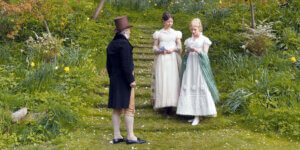A walk through time in streets of the Historic Centre of Naples
As someone born in a small sea town a stone’s throw from Naples, I have always known what the city has to offer, its history and art. Still, like many people, my idea of traveling includes stressing over luggage weight and plug adaptors. For as interesting as one’s area might be, it’s easy to take it for granted and think that the” touristy stuff” is just not something locals do.
This is not Naples’ fault, mind you. It’s no coincidence that the city is a pop culture darling, with some of the most internationally well-known Italian works of fiction set in the city. Take, for example, the book series “My Brilliant Friend” by Elena Ferrante, the TV show “Mare fuori,” and most recently, the A24 film “Parthenope” by the Academy Award-winning filmmaker Paolo Sorrentino, which premiered at Cannes this year.
Recently, a long-distance friend who has been reading Ferrante’s work asked me about some of the many places in the city that pop up in her novels. That made me realize that it has been years since I had bothered being a “tourist in my own town,” properly visiting places instead of passing by on my way to get something done. So, I have decided to take some time to do just that and visit the heart of the city: its historic center.
Stepping into Naples’s historic center, one is immersed in an open-air architectural history book. The city displays its long past with buildings from all its eras, creating a unique blend of architectural styles that made it a UNESCO World Heritage Site.
One can witness Naples’s historic center’s wealth of architectural styles and eras as soon as they step onto the harbor, which has historically been at the heart of the city’s life, trade, and identity.
A short walk from its harbor stands, in fact, the Maschio Angioni or Castel Nuovo, the highlight of the seaside area that appears in many scenes from “Mare Fuori.” This medieval trapezoid-shaped castle was built in 1279 during the reign of one of the city’s many foreign rulers, Carlo I d’Angiò and designed by the French architect Pierre de Chaule. The materials used to build this medieval seaside castle were local ones generated from the area’s volcanic activity: the dark grey piperno and sand-colored tuff.
On the far north of the nearby Piazza del Municipio, the architecture takes passersby a few centuries ahead, straight to the early nineteenth century. That’s when Ferdinando I di Borbone decided to build Palazzo San Giacomo, the Italian city’s current town hall. This neoclassical bicolored building contains more than 800 rooms and replaced a series of older buildings from the 16th century, a common practice in a city with a long history.
Another plaza, Piazza del Gesù Nuovo, offers a unique architectural journey not far from the town hall area. This plaza is a historical gem that cinephiles might recognize from De Sica’s “Marriage Italian Style” (1964) with Sophia Loren and Marcello Mastroianni. There, the two warm-toned palazzo Pandola and palazzo Pignatelli di Monteleone, both originally from the Baroque period, face a rather minimalist small medieval church, the Gothic Chiesa di Gesù Redentore e San Ludovico d’Angiò.
That’s not all there is to see there, though, as in this plaza, one can also admire one of the most well-known religious buildings in town: the Santa Chiara Monastery, opened to the public in 1340. This mastodonic Gothic building tells hundreds of years’ worth of the city’s artistic and architectural history despite the bombing that, during World II, almost razed it to the ground. The building’s crown jewel, in fact, is its majolica tiled cloister, built in 1742, which also features the city’s most wholesome artwork: a tile decorated with a painting of a nun feeding the local cats.
Walking a few steps, one can time travel back to the Renaissance by visiting the Baroque Chiesa del Gesù’ Nuovo, a church completed in 1601 and built in the so-called Greek cross structure. This building’s striking dark facade in diamond-shaped piperno bossage results from some old-school repurposing. It was part of an older palace belonging to the noble Sanserverino family. Its peculiar marks are the protagonists of many legends and theories, but it’s, regardless, one of Naples’s most visually striking buildings.
Theatricality was, after all, the trade of that century’s main architectural style, the Barocco, all over the peninsula, which in Naples took a specific, local form: the Barocco Napoletano. In a bright-colored street called Via Vergini, people can admire an Escher-esque example of the city’s take on Barocco, Palazzo dello Spagnolo. This building, with its double flight-ed main staircase for an internal facade, rococò style stucco decorations, and green accents, is the work of none other than architect and painter Ferdinando Sanfelice, who is credited with making stucco decorations fashionable in the city.
Its trend sensitivity is no surprise, as Naples is, at the end of the day, a place where architectural styles and trends not only found a place to flourish but interacted with local traditions and influences and whose examples are still standing today despite a plethora of foreign donations, bombings, earthquakes, and volcanic eruptions. This resilience, which is part of the city’s DNA, is why, in Naples, one can find centuries-old beauty around every corner.




























